
Purchase Tickets
Let’s Talk About Paper IV
April 19, 2012
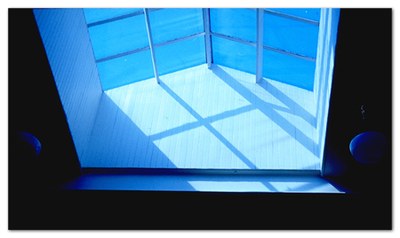
Ok, storage seems simple, but beyond handling with care, how and where our valuables are stored will actually affect long-term preservation. Materials should be guarded from light, excess heat and humidity, harmful pollutants and pests as well as human error.
Light can actually initiate and accelerate damage. Ultraviolet light is the most harmful, causing paper to darken and inks and dyes to fade. Both fluorescent lamps and daylight contain very high levels of UV light. Now here is the confusing part … most people are switching their indoor lamps to compact fluorescent bulbs, and are unaware of actually introducing a source of UV light in their home environment. This can lengthen the exposure of sensitive materials like paper and textiles to UV light when lamps are turned on. Some compact fluorescent bulbs are made with a second layer of glass that filters out the UV. The curly bulbs do not have these filters, so you might wish to do some investigating at your local hardware store if you have Aunt Betty’s diploma framed and placed on a dark wall by day, but near a lamp by night!
Extremes in heat and humidity are not good for our family books and documents and probably occur most often in basements, attics and out-buildings like garages and barns. High temperatures will make paper and leather brittle, increase stress on the fragile structure, and result in overall weakening and tears. At the other extreme, dampness will encourage the creepy things … like mold and insect infestation.
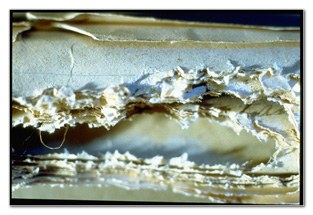
Cellulose in paper and proteins in leather and glue used during bookbinding provide a great source of food for insects. Providing a stable or moderate temperature and relative humidity helps insure against damage that results from mildew, mold and insects. So let’s talk about how wephysicallystore things.
Acid-free is a term given to modern manufactured paper products that contain a safe substance called an alkali to help counteract the formation of acids. These agents protect cellulose against future acid attack from pollutants that can break down the fiber and cause harm inside the storage environment. The acid in acidic boxes and folders will transfer overtime to the original documents they are meant to protect. Acid free folders and papers used to store cellulose materials (like paper documents) contributes greatly to their long-term preservation.
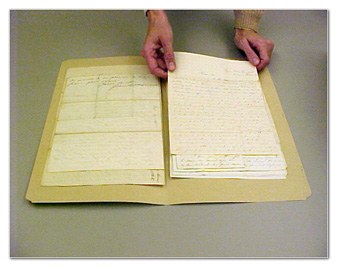
Support paper collections in acid-free folders and interleave items with acidic inks or tapes with acid-free bond.
Individual items that are fragile and need support are provided with sleeves of Mylar. Mylar and polyethylene are clear films made of polyester that are chemically inert. That means they will not breakdown and emit harmful solvents like plastics do; causing them to get sticky or oily as they age. Avoiding foams and plastics in the storage environment is important so pollutants do not build up inside the storage container.
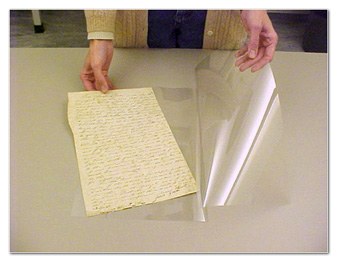
Support fragile manuscripts and other paper materials that may have tears or areas of loss inside Mylar sleeves.
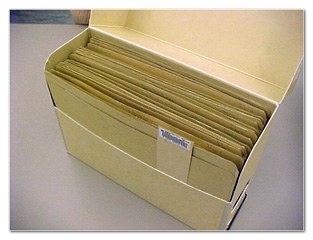
Place the acid-free folders upright inside acid-free document cases. These come in legal and letter size. Choose the size that is right for the dimensions of your largest item.

Fill any voids that may be in the back of your document case with a good quality paper or foam so files stay upright. Otherwise the files will slump and so will the contents! There are also flat boxes that can be used, too.
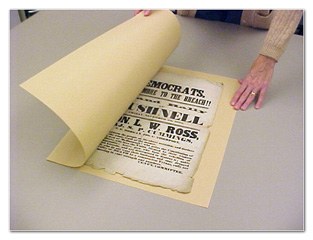
Any paper objects that are larger than usual, like this broadside, are provided with a larger acid-free folder.
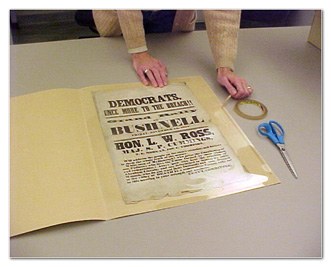
The item is stabilized in the folder with a sheet of Mylar held into place on the back of the folder by double-sided Mylar-based tape. This tape is made especially for the conservation field by 3M.
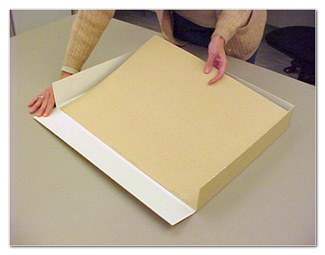
The oversized folder goes into an oversized acid-free box. The archival companies have lots of sizes all figured out, and their folders fit their boxes perfectly. It’s all good!
So there you have it. Now is the time to look at your schedule, clear a work area, get that box out of the closet, and get your notes going as you go through bundles or little hankies wrapped with a bow. Make some measurements, order your supplies and handle with care. If you find that you have questions about your family documents and how to best preserve them, please do not hesitate to contact our conservators in the Conservation Department at IHS. We take time out to meet with members of the public to discuss your concerns and make recommendations about their care. So give us a call … we can talk about when to use white gloves.
____________________








